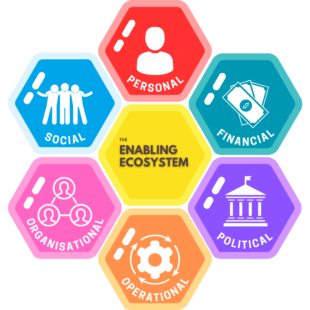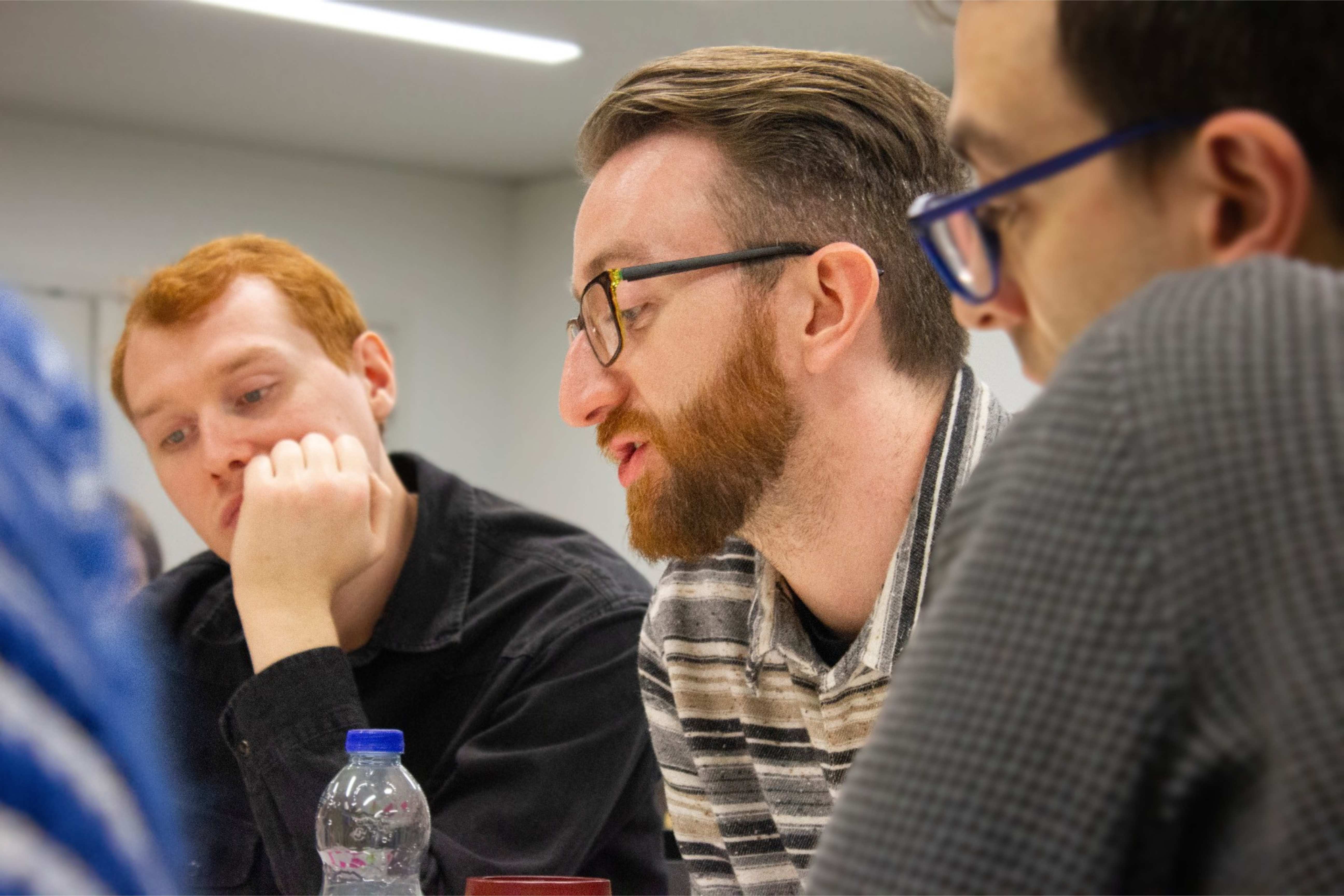Finances, operations and organisations are critical aspects of the bureaucratic environment that public entrepreneurs must work in.

This is the fourth of final blog posts describing my experiences in establishing and running the Innovation Lab in the Department of Finance in Northern Ireland.
Innovators in the public sector operate within an Enabling Ecosystem. In my previous posts we explored your personal influence on the system, and how to work with other people and politicians.
Now in this final post, I take a look at the financial, organisational and operational parts of the ecosystem.
Money makes the world go round
Successful innovation requires financial resources (people and funding) and your organisation will have procedures for estimating project costs, seeking approval and releasing funding. You will need to make the case to create an innovation project and then for the necessary resources. Ask yourself: Are you familiar with this and do you have the ability to scope out your project and estimate costs? Are you aware of the financial/budgetary system within which you will need to secure these approvals? This may take the form of a Strategic Outline Case.
During the life-cycle of your project you may need additional permissions and funding to carry out testing and iterations of your innovation; this too will require approvals and funding. These will be in the form of Business Case, the extent of which will be commensurate with the level of funding sought.
In assessing the effectiveness of your innovation and variants of it, you will need access to data, assistance with estimating costs, and even the input of an Economist to fully and independently evaluate your proposal. In this instance you may need to develop a Full Business Case to secure approval and funding to implement.
The extent to which you may be successful will also depend on the way in which the business case process works and how innovation and investment in experimentation is viewed. You may wish to assure yourself that the business case process provides for upfront investment for longer term outcomes, and ‘recognises’ that savings / outcomes may come later in the lifetime of the investment.
Accessing external funding
External to your organisation there may be philanthropic funds, or regional funds, which can be accessed as a source of funding. Perhaps the problem you wish to solve, should be specified and then put to the market through initiatives such as the Small Business Research Initiative, which enables the public sector to tap into new technologies and innovative businesses which are better positioned to develop possible solutions.
Research grants
Another source may be to apply for a research grant particularly where there is alignment between the challenge you are addressing and the area into which the available funds are being targeted. For example, the Arts and Humanities Research Council and Innovate UK are potential sources of funding.
The incentive infrastructure your leaders create
I think of the organisational segment as the authorising environment. This is the body or authority or organisation within which you need to have freedom to innovate, obtain approvals (and funding) – unless you happen to be sufficiently senior to do so in your own right!
Your success will depend to some degree at least on the prevailing culture and the way in which creativity and innovation are viewed. For example, does your organisation genuinely encourage innovation? By that I mean does it purport to promote innovation, but in practice Public Entrepreneurs find it difficult, even impossible, to be innovative because the lived experience (the real culture) is one where innovation/change is discouraged or frustrated.
The degree to which the leadership of an organisation is really interested in innovation will be reflected not in the language of mission statements but in actual investment in innovation and the promotion and celebration of success. It will be where the leadership team are themselves good exemplars of innovation who by their behaviour promote a culture where Public Entrepreneurs flourish, feel at home and are valued.
Another test is the degree of risk appetite or the level of risk averseness in the system. Another indicator is the recognition that innovative ideas need developed, tested and iterated to get a good solution. Allied to this is a recognition that some ideas/projects will fail, which is a test of the risk appetite. Consideration of these factors is an important test of the innovation-readiness of the organisation in which you wish to succeed as a public entrepreneur.
User-Centred Design
Over the years I have been constrained by budget limitations and have had to be satisfied with delivering less than perfect solutions, and, perhaps unsurprisingly, later found they didn’t produce the outcomes we intended. It is only recently in the public sector we are seeing the importance of user-centred design and the benefits it can deliver. It is a challenging concept to grasp but, once the penny drops, it makes sense. Think of a high-quality product or service you are familiar with; did it happen by accident? I like to cite a BMW car to illustrate my point here – you will think of other examples. Why is a BMW so highly sought after? The fact is that the BMW company determined their vehicles will be excellent; and they designed and engineered then accordingly. Now, while I appreciate that we don’t have the resources of a commercial organisation, I do think we should equally go out of our way to make sure our services are excellent, and it should be our objective to design them to be so. If we want the societal outcomes we espouse from public intervention then we must invest in design, development and implementation. It is public money after all; and for many citizens our interventions are vital to their lives. So, it is worth asking if you will be permitted to innovate in this way, since the cost of not doing so can be significant, and many failed initiatives testify to this – Margaret Hodge’s book Called to Account helps put some of this into perspective.
The question arises as to whether you are a good fit with the organisation in which you want to be innovative. Will you have the freedom do so or will you be endlessly frustrated by the system or by line managers who don’t see things as you do?
Making it work for frontline workers
There is always an operational area, business stream, or live service into which your innovation must land and be delivered so that project objectives are realised in better services, improved outcomes, reduced costs etc.
While you may be remote from that operational area, you cannot meaningfully expect to successfully innovate and land your ideas into it, without engagement with the leadership and involvement of the staff.
Think about: is there change fatigue? Is there a willingness to change amongst the cohort of operational management and staff? Are you willing to involve them in seeing the need for the innovation and in developing the solution and implementing the change? How creative and innovative is management and staff? Are they ready for change?
At grass roots level is there a strong bond with the current system or are these viewed as dysfunctional, faulty and in need of replacement? In other words, is there an appetite for change that you can tap into in terms both of the energy it will bring and the knowledge, skills and ideas that are latent in the people working in the system? Understanding these dynamics can help avoid some common pitfalls and give your initiative momentum. Or are you at risk of failing to see the value to be derived from engaging the people who really know the issues and potential solutions? It really is a lost opportunity to ignore these people and fail to tap into their energy and expertise. These are simple mistakes to make but equally they are relatively easy to avoid
Enable yourself to innovate
As I set up Innovation Lab projects I look for certain factors to determine in my own mind if there is a good basis for a project – in other words is there an Enabling Ecosystem in place. Similarly, it is advisable to have a long hard look at the elements of the ecosystem before embarking on your innovation journey.
Not that this exercise should take on the formality (or replace) of a Strategic Outline Business Case, or a Gateway Review, but in many ways it should come before either of these. You should get a good sense of the ecosystem. A lot of frustrations can be anticipated and managed, and nugatory work avoided, if you understand the complexity of the ecosystem and the challenges arising from the components of it.
It should give a clear view of the challenges you will have to address; it can also help you see where preparatory work will be needed and, in some instances, might prevent you from embarking on a project that has little or no chance of success.
On the up-side of course, assuming the ecosystem indicators are all favourable, or you are aware of and are ready for the challenges, then the real hard work of innovation can begin
Join our community
We use this blog to talk about the work of the multidisciplinary policy design community. We share stories about our work, the thinking behind it and what policymaking might look like in the future. If you would like to read more, then please subscribe to this blog. If you work for the UK’s government, then you can you join the policy design community. If you don’t work for the UK government, then connect with us on social media at Design and Policy Network and subscribe here to be notified about our monthly speaker events to hear from influential design thought leaders and practitioners.











